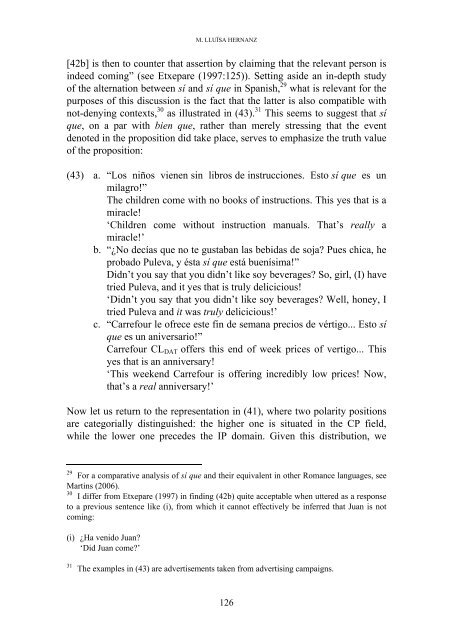Emphatic Polarity and C in Spanish - Lear
Emphatic Polarity and C in Spanish - Lear
Emphatic Polarity and C in Spanish - Lear
Create successful ePaper yourself
Turn your PDF publications into a flip-book with our unique Google optimized e-Paper software.
M. LLUÏSA HERNANZ<br />
[42b] is then to counter that assertion by claim<strong>in</strong>g that the relevant person is<br />
<strong>in</strong>deed com<strong>in</strong>g” (see Etxepare (1997:125)). Sett<strong>in</strong>g aside an <strong>in</strong>-depth study<br />
of the alternation between sí <strong>and</strong> sí que <strong>in</strong> <strong>Spanish</strong>, 29 what is relevant for the<br />
purposes of this discussion is the fact that the latter is also compatible with<br />
not-deny<strong>in</strong>g contexts, 30 as illustrated <strong>in</strong> (43). 31 This seems to suggest that sí<br />
que, on a par with bien que, rather than merely stress<strong>in</strong>g that the event<br />
denoted <strong>in</strong> the proposition did take place, serves to emphasize the truth value<br />
of the proposition:<br />
(43) a. “Los niños vienen s<strong>in</strong> libros de <strong>in</strong>strucciones. Esto sí que es un<br />
milagro!”<br />
The children come with no books of <strong>in</strong>structions. This yes that is a<br />
miracle!<br />
‘Children come without <strong>in</strong>struction manuals. That’s really a<br />
miracle!’<br />
b. “¿No decías que no te gustaban las bebidas de soja? Pues chica, he<br />
probado Puleva, y ésta sí que está buenísima!”<br />
Didn’t you say that you didn’t like soy beverages? So, girl, (I) have<br />
tried Puleva, <strong>and</strong> it yes that is truly delicicious!<br />
‘Didn’t you say that you didn’t like soy beverages? Well, honey, I<br />
tried Puleva <strong>and</strong> it was truly delicicious!’<br />
c. “Carrefour le ofrece este f<strong>in</strong> de semana precios de vértigo... Esto sí<br />
que es un aniversario!”<br />
Carrefour CLDAT offers this end of week prices of vertigo... This<br />
yes that is an anniversary!<br />
‘This weekend Carrefour is offer<strong>in</strong>g <strong>in</strong>credibly low prices! Now,<br />
that’s a real anniversary!’<br />
Now let us return to the representation <strong>in</strong> (41), where two polarity positions<br />
are categorially dist<strong>in</strong>guished: the higher one is situated <strong>in</strong> the CP field,<br />
while the lower one precedes the IP doma<strong>in</strong>. Given this distribution, we<br />
29<br />
For a comparative analysis of sí que <strong>and</strong> their equivalent <strong>in</strong> other Romance languages, see<br />
Mart<strong>in</strong>s (2006).<br />
30<br />
I differ from Etxepare (1997) <strong>in</strong> f<strong>in</strong>d<strong>in</strong>g (42b) quite acceptable when uttered as a response<br />
to a previous sentence like (i), from which it cannot effectively be <strong>in</strong>ferred that Juan is not<br />
com<strong>in</strong>g:<br />
(i) ¿Ha venido Juan?<br />
‘Did Juan come?’<br />
31 The examples <strong>in</strong> (43) are advertisements taken from advertis<strong>in</strong>g campaigns.<br />
126

















